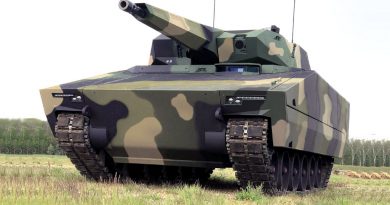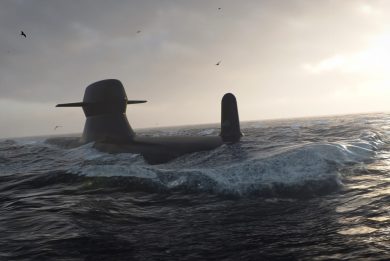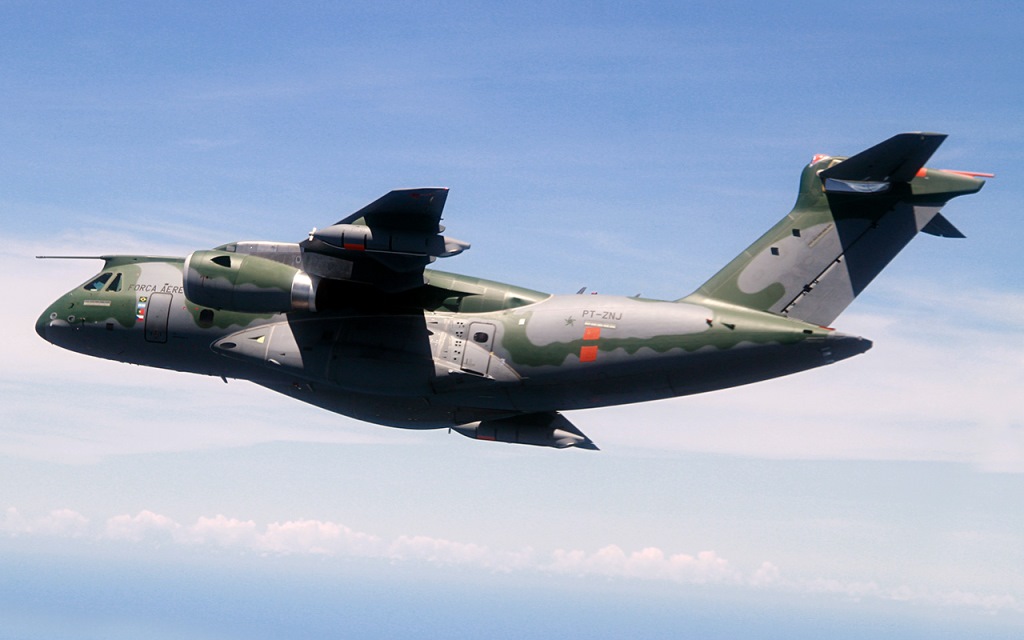
LAAD 2023 – Embraer strongly pushes its C-390 Millenium on the international market
Following the announcement at LAAD 2023 of the agreement with Saab, the Swedish company being now involved in the C-390 Millenium marketing in Europe and firstly in Sweden, Embraer provided a full briefing on the latest about its Millenium transport/tanker aircraft.
With an ageing fleet of C-130H still in service around the world, some 22 aircraft are between 32 and 42 years old, the Brazilian airspace champion company looks with interest at replacing those with its twin-jet aircraft, the C-390 Millenium.
«The new C-390 Millenium aircraft it proved its effectiveness in a number of humanitarian missions»
In operation with the Brazilian Air Force (FAB) since September 2019, the service has now five aircraft in service and declared the Full Operational capability in March 2023. The new aircraft it proved its effectiveness in a number of humanitarian missions and military exercises. The C-390 first international mission was the delivery to Lebanon of 6,000 kg of medical supplies following the explosion in the Beirut harbour. Between 12 and 13 August 2020 one C-390 flew from São Paulo to Fortaleza, then to Cabo Verde, Valencia and finally Beirut, for a total of 15:51 flight hours, 34 counting the return flight.

In 2020/21 the aircraft supported the fight against COVID in Brazil transporting some 1,800 tonnes of supplies for a total of 600 flight hours, connecting a number of locations inside the country, taking off from the three main cities, São Paulo, Rio de Janeiro and Brasilia. Loads included vaccines, liquid oxygen, medical equipment, ambulances and even a field hospital. In August 2021 the C-390 was once again in the air to transport humanitarian aid following the magnitude 7.2 earthquake that hit Haiti. Overall 10,500 kg of materiel and 32 Brazilian fire-fighters were transported to Port-au-Prince from Brasilia.
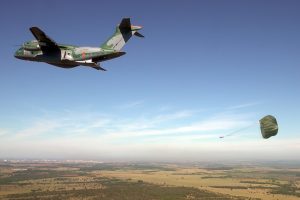
These missions did not stopped the development of the aircraft capabilities. Airdrop at low and high altitude was certified, including the continuous computerised drop point calculation system integrated in the airplane avionics. Twenty-four CDS (Container Delivery System) 48×48 inch were dropped in sequence in a single pass, as well as a 19 tonnes single load at low altitude low velocity, this capability going up to 24 tonnes. In March 2022 a FAB C-390 flew to Warsaw from Brasilia along the Recife, Cabo Verde, Lisbon route, taking on board on the return flight 68 civilian, 42 Brazilians, 20 Ukrainians, 5 Argentinians and one Colombian, of which 14 children, escaping the conflict in Ukraine. On the way in the aircraft carried 11,000 kg of supplies, the whole mission lasting 30 flight hours. In 2023 the FAB transport aircraft are routinely delivering via airdrop supplies to the Yanomami tribal people living between the Orinoco and the Amazon rivers. These daily deliveries consist of simultaneous airdrops of 10 CDS, standard circular error being under 50 meters according to data provided by the FAB.
«First involvements in international military exercises and more»
Military activities saw one C-390 taking part in the US Culminating Exercise 2021; this took place in Louisiana in January and saw a combined US-Brazilian paratroopers airdrop led by 9 USAF C-17 that overflew the drop zone at 2 minutes interval, followed after a 5 minutes gap by six USAF C-130J dropping their loads at 30 seconds interval, and finally 5 minutes later by the FAB C-390. In September that same year FAB C-390s took part in Operation Cooperacion VII in Colombia, operating on runways up to 2,100 meters altitude, carrying out simulated humanitarian assistance missions, including paratroopers airdrops, within the SICOFAA (System of Cooperation among the American Air Forces) scheme. In June 2022 the first resupply airdrop of the Brazilian research station in the Antarctica was performed; 10 loads containing 2,500 kg of food and supplies were dropped on a 400×200 meters drop zone. No landing is planned for the time being, this requiring an operational need as well as favourable climate conditions, such operations being carried out jointly by the FAB and Embraer.
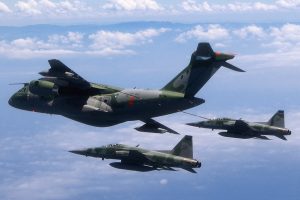
Air-to-air refuelling capabilities were certified, day and night, with the F-5M and A-1M at speeds between 180 and 300 knots and altitudes up to 32,000 ft, with a fuel transfer flow up to 1,800 litres per minute. Ballistic protection, self protection and inert gas generation systems have also been qualified. This led to the FAB participation in exercise Salitre IV in Chile, which saw the redeployment of one KC-390 and six F-5. Fifty combat missions were carried out with a 100% availability of the tanker that performed the first in-fight refuelling on an international mission. Another certified capability is the use of roll-on/roll-off auxiliary fuel tanks each carrying 4,000 kg of extra fuel. These are used mostly in Search And Rescue missions, the SAR kit including two such tanks as well as doors with bubble windows for observers, a SAR radar in addition to IR sensors. In the SAR configuration the C-390 is certified to operate up to the mid-Atlantic. As for unpaved/unprepared operations the C-390 proved to be able to operate on CBR (California Bearing Ratio) 4 to 8. For fire-fighting missions the C-390 employs the MAFFS II (Modular Airborne Fire Fighting System), doors being replaced to allow for the hoses spraying the retardant hosted in the 11,000 litres tank.
In the first 3.5 years of operation the FAB C-390 totalled over 8,200 flight hours with 6,000 flying cycles, with a technical availability of 80% and a mission completing rate of 99.5%, according to data provided by Embraer and the FAB. Fourteen more aircraft must be delivered to Brazil, that of the 6th being awaited for late April this year, the seventh being on the assembly line while subassemblies for the eight one are being readied.
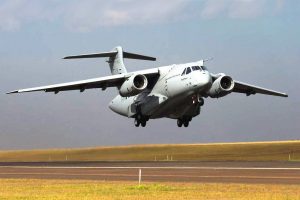
Portugal received its first aircraft in late October 2022, the plane being currently fitted to the NATO configuration. This includes the MIDS JTRS Link-16 by Viasat, a military GPS provided by Thales, an IFF/Transponder Mode 4/5 with crypto KIV-77, an HF radio with a KY-100 lightweight terminal for secure voice communications, and a dual V/UHF AN/ARC-210 Integrated Communications System. A JPADS airdrop capability with GPS antennas providing location signal to both cockpit and cargo compartments to programme tablets and automated guidance units will also be installed. Hungary signed for two aircraft and the Netherlands for five, all these being delivered up to NATO standard.
«The way ahead: adding further flexibility»
New modules are being developed, among which a roll-on/roll-off aero-medical bio-container ones available in different layouts, clean room, intensive care unit (ICU), seating ambulatory, or MEDEVAC. One configuration shown at LAAD was based on seven modules; moving from the front module n.1 hosted four passengers and the lavatory, n.2 and n.4 hosted two ICU beds, n.3 and n.5 one ICU bed and two seats for medical personnel, while n.6 and n.7 were payload containers. In MEDEVAC configuration two bigger containers hosting 36 stretchers each can be installed, followed by the usual two cargo containers.
However one of the most interesting developments, carried out in cooperation with L3Harris, is the KC-390 Agile tanker, which will be fitted with a flying boom allowing to considerably widen the type of aircraft that can be refuelled by the Millenium, F-16s and F-35s being part of those. The KC-390 Agile will be the first aircraft with ramp to be fitted with a boom refuelling system, which brings with it some complexity Embraer admits, however the company also underlined that the system will be modular therefore the aircraft will be reconfigurable in its standard role.
It is to note that FAB Gripens have not yet started air refuelling missions with the C-390; they will exploit wingtip hose and drogue systems, however according to Embraer those tests were not part of the original contract, therefore they are planned for 2024. Opening up this capability will be key not only for Brazil but also for Hungary, which also flies the fighter of Swedish origin, as well as for Sweden itself, this being a plus in the marketing campaign in that country, which fleet of Gripen is destined to further increase.
Photos courtesy Embraer and Brazilian Air Force

